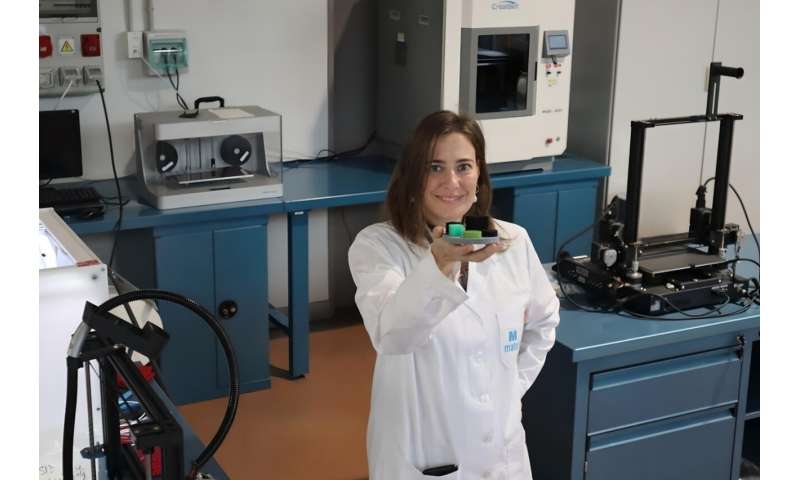Charting a course to greener skies: IMDEA Materials Institute looks to tackle the aeronautical industry's big recycling

Currently, nearly 98% of end-of-life carbon-fibre-reinforced polymers (FRPs) end up in landfills, presenting a critical sustainability bottleneck in the aeronautical and aerospace industries.
IMDEA Materials Institute researchers aim to demonstrate the potential for recyclable, high-performance thermoplastic cellular solids (HPTCs) to replace FRPs in the production chain.
In recent years, manufacturers have increasingly turned to lightweight plastic or fibre-reinforced plastic polymers to replace traditional metal components.
This is particularly the case in the aerospace industry, where studies have shown that at least 30-40% of modern airframes are now constructed from polymer composite materials, a number that is only increasing.
The idea of passengers one day flying around the world on 'plastic planes', is perhaps not as far-fetched as it might at first appear. The motivation for this manufacturing evolution is simple: polymers make aircraft lighter and thus, most crucially, more fuel efficient.
However, while improved fuel efficiency is considered key in developing an eco-friendlier airline industry, the use of such fibre reinforced polymers (FRPs) is not without its drawbacks. The principal of these being that FRPs are, themselves, inherently unsustainable, owing to the difficulty of their recycling.
"Typically, when you need a multifunctional material, for example, a component that is not only loadbearing, but which also acts as an insulator, the most straightforward way to achieve that, is to layer different materials with differing properties and bond them together," explains IMDEA Materials Institute's Dr. Lucía Doyle.
"These types of FRPs in the form of monolithic and sandwich structures are nowadays heavily used in lightweight driven aerospace applications".
"The problem is that layered materials present enormous complications when it comes to recycling as they often consist of different types of polymers and/or have additional materials such as adhesives, resins or coatings that can make recycling them extremely difficult, if not impossible".
"To give a more concrete example, nearly 98% of end-of-life FRPs end up in landfills, so there is an urgent need for the development of high-performance engineering materials based on green engineering criteria", she adds.
In order to help solve this catch 22, whereby carbon emissions are lowered but at the cost of increased plastic waste, Dr. Doyle recently embarked on the HipPEEK project.
HipPEEK, funded by the European Union's 2022 Horizon Europe MSCA Postdoctoral Fellowships programme (gr. no. 1010106955), aims to develop a new processing technique for 3D-printed high-performance thermoplastic cellular solids (HPTCs).
Specifically, the project will focus on Poly(ether-ether-ketone), more commonly known as PEEK, a high-performance engineering thermoplastic with a high strength-to-weight ratio.
PEEK is considered a prime candidate to replace metals in a variety of applications, not only in aerospace and aeronautics, but also in the automotive, medical, and dental industries, which can also benefit from the cellular structures developed in HipPEEK. The material will be designed and produced through a cutting-edge combination of physical foaming techniques and 3D printing.
In effect, the combination of environmentally friendly physical foaming using inert gases, with the production of three-dimensional scaffolds through resource efficient 3D printing, will allow the production of controlled multiscale hierarchical structures on the micro and mesoscales, together with optimised topology at the macro scale.
Crucially, this will afford researchers the possibility of tailoring properties within the material by modifying its microstructure.
"The idea really, is to find how far we can go in tailoring PEEK to offer multifunctional properties, without the need to blend it, or layer it, with other materials," says Dr. Doyle. "We can do this by manipulating its microstructure."
"If you look at loadbearing structures in nature, like bone, they are typically cellular, and there are always gradients at the cellular level that optimise multifunctionality including strength, toughness, weight, fluid transport etc."
"We will be producing a cellular PEEK with two levels of porosity, to maximize weight reduction while maintaining the part's performance".
And it's not just the presence of such multifunctional materials in nature that serve as inspiration for the Marie-Skłodowska Curie Actions (MSCA) fellow and Autonomous University of Madrid graduate.
Dr. Doyle is also a firm adherent of the Cradle to Cradle and Safe and Sustainable by Design (SSbD) concepts, whereby products or manufacturing processes are designed to mirror natural systems.
"In nature, there is no waste," says Dr. Doyle. "Waste is a human concept; no other organism produces waste, because everything that is produced is reused within its ecosystem."
"That's the whole philosophy behind these concepts, and behind the HipPEEK project. To develop processing techniques which result in materials which can, in effect, be endlessly reused and recycled, in a way analogous to what we see in nature."
More information:
www.researchgate.net/publicati … -Aviation-Sector.pdf
Jin Zhang et al, Current status of carbon fibre and carbon fibre composites recycling, Composites Part B: Engineering (2020). DOI: 10.1016/j.compositesb.2020.108053
Provided by IMDEA Materials